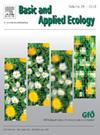Invasive common milkweed strongly simplifies insect flower-visiting networks
IF 3.5
2区 环境科学与生态学
Q2 ECOLOGY
引用次数: 0
Abstract
Plant invasion and habitat fragmentation are significant global drivers threatening biodiversity. Synergistic interactions between these processes can lead to even more significant biodiversity loss than when they act alone. However, their effects on flower visiting insects and their food resources are complex and lack a general consensus. In this two-year study, we analysed the structural changes in plant-flower visitor networks in response to the interaction between common milkweed (Asclepias syriaca) invasion and fragment size. We selected natural forest-steppe grassland fragments along a gradient of fragment sizes in Hungary by designating invaded and control areas in each to survey flower visitors and their food plants before and during milkweed flowering. We found that Shannon diversity and generality of networks were significantly lower in milkweed-invaded areas compared to control areas during milkweed flowering. More diverse networks were observed in the control areas. Functional complementarity and the cluster coefficient of networks were significantly higher in milkweed-invaded areas compared to control areas during milkweed flowering. However, we found no effect of fragment size. Our results showed that during its flowering period, milkweed significantly impacted and simplified flower-visiting insect networks. The flowers of the invasive milkweed attracted flower visitors with suitably long tongues, potentially disrupting local flower-visiting species. Our research highlights that exploring networks provides valuable insights into the indirect consequences of plant invasion and offers new knowledge for habitat restoration efforts.
入侵的普通马利筋极大地简化了昆虫访花网络
植物入侵和生境破碎化是威胁生物多样性的重要全球驱动因素。这些过程之间的协同相互作用可能导致比它们单独行动时更严重的生物多样性丧失。然而,它们对访花昆虫及其食物资源的影响是复杂的,缺乏普遍的共识。在这项为期两年的研究中,我们分析了普通马利筋(Asclepias syriaca)入侵和片段大小相互作用下植物-花访问者网络的结构变化。在匈牙利,我们选择了不同大小的天然森林-草原草地片段,在每个片段中指定入侵区和控制区,在马利筋开花前和开花期间对访花者及其食物植物进行了调查。结果表明,在马利筋开花期间,马利筋入侵区Shannon多样性和网络的一般性显著低于对照区。在对照区观察到更多不同的网络。在马利筋开花期间,马利筋入侵区网络的功能互补性和聚类系数显著高于对照区。然而,我们没有发现碎片大小的影响。结果表明,马利筋在花期显著影响和简化了访花昆虫网络。入侵的马利筋的花以适当的长舌头吸引了花游客,潜在地扰乱了当地的花游客物种。我们的研究强调,探索网络为了解植物入侵的间接后果提供了有价值的见解,并为栖息地恢复工作提供了新的知识。
本文章由计算机程序翻译,如有差异,请以英文原文为准。
求助全文
约1分钟内获得全文
求助全文
来源期刊

Basic and Applied Ecology
环境科学-生态学
CiteScore
6.90
自引率
5.30%
发文量
103
审稿时长
10.6 weeks
期刊介绍:
Basic and Applied Ecology provides a forum in which significant advances and ideas can be rapidly communicated to a wide audience. Basic and Applied Ecology publishes original contributions, perspectives and reviews from all areas of basic and applied ecology. Ecologists from all countries are invited to publish ecological research of international interest in its pages. There is no bias with regard to taxon or geographical area.
 求助内容:
求助内容: 应助结果提醒方式:
应助结果提醒方式:


